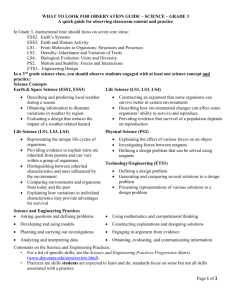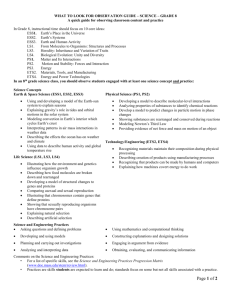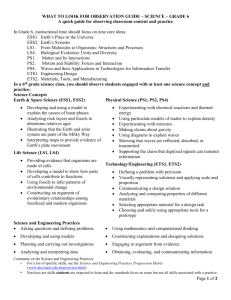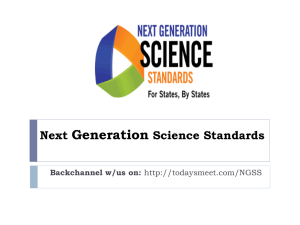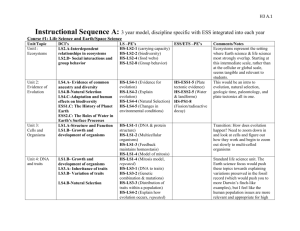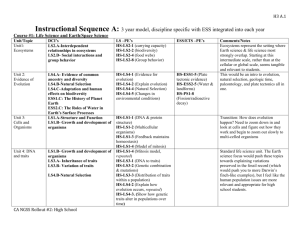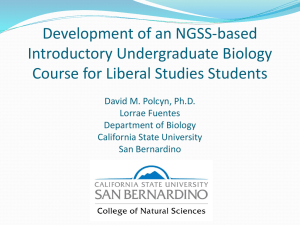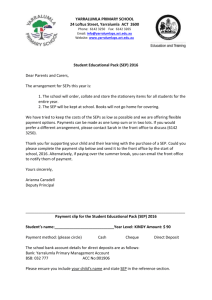Biology Units - University High School
advertisement
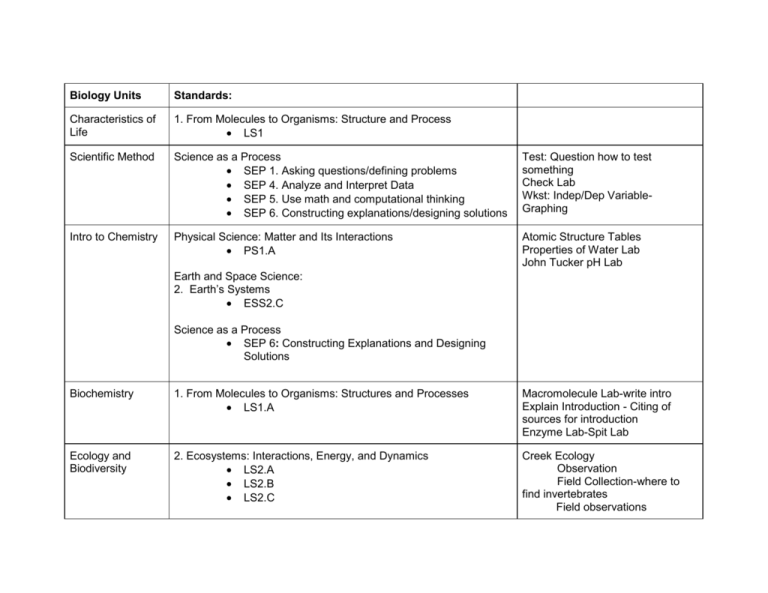
Biology Units Standards: Characteristics of Life 1. From Molecules to Organisms: Structure and Process LS1 Scientific Method Science as a Process SEP 1. Asking questions/defining problems SEP 4. Analyze and Interpret Data SEP 5. Use math and computational thinking SEP 6. Constructing explanations/designing solutions Test: Question how to test something Check Lab Wkst: Indep/Dep VariableGraphing Intro to Chemistry Physical Science: Matter and Its Interactions PS1.A Atomic Structure Tables Properties of Water Lab John Tucker pH Lab Earth and Space Science: 2. Earth’s Systems ESS2.C Science as a Process SEP 6: Constructing Explanations and Designing Solutions Biochemistry 1. From Molecules to Organisms: Structures and Processes LS1.A Macromolecule Lab-write intro Explain Introduction - Citing of sources for introduction Enzyme Lab-Spit Lab Ecology and Biodiversity 2. Ecosystems: Interactions, Energy, and Dynamics LS2.A LS2.B LS2.C Creek Ecology Observation Field Collection-where to find invertebrates Field observations LS2.D 4. Biological Evolution: Unity and Diversity LS4-6 Earth Science 3. Earth and Human Activity ESS3.C ESS3.D Identification Write a procedure Organize data Graph data Analyze graph data Invasive species activity Carp Bioaccumulation Activity Engineering Design ETS1.B Science and Engineering Practices SEP1: Asking questions (for science) and defining problems (for engineering) SEP2: Developing and using models SEP 3: Planning and carrying out investigations SEP 4: Analyzing and interpreting data SEP 5: Using mathematics and computational thinking SEP 6: Constructing explanations (for science) and designing solutions (for engineering) SEP 7: Engaging in argument from evidence SEP 8: Obtaining, evaluating, and communicating information Cell Biology 1. From Molecules to Organisms: Structures and Processes LS1 Cell Respiration 1. From Molecules to Organisms: Structures and Processes LS1-2 Rollin’ in the Dough Lab and Guided Independent Research LS1-7 2. Ecosystems: Interactions, Energy, and Dynamics LS2-3 Science and Engineering Practices: SEP1: Asking questions (for science) and defining problems (for engineering) SEP2: Developing and using models SEP 3: Planning and carrying out investigations SEP 4: Analyzing and interpreting data SEP 5: Using mathematics and computational thinking SEP 6: Constructing explanations (for science) and designing solutions (for engineering) SEP 7: Engaging in argument from evidence SEP 8: Obtaining, evaluating, and communicating information Lab Report: -Introduction -Design and write procedure -Data collection -Graphing of data -Writing a conclusion Photosynthesis 1. From Molecules to Organisms: Structures and Processes LS1.C. Chromatography Lab Photofinish Lab DNA/RNA 1. From Molecules to Organisms: Structures and Processes LS1.A 3. Heredity: Inheritance and Variation of Traits LS3.A LS3.B Strawberry DNA Extraction Lab Cell Division 1. From Molecules to Organisms: Structures and Processes LS1.B Modeling Meiosis with Oreo Cookies Mitosis Onion Root Tip Lab Debate Engineering Design ETS1-3 STEM Cell Debate Genetics 3. Heredity: Inheritance and Variation of Traits LS3.A LS3.B Genetic Disorder Research History of Life Earth and Space Science 2. Earth Systems ESS2.B Radioactive M&m’s Activity Evolution 4. Biological Evolution: Unity and Diversity LS4.A LS4.B LS4.C Battle of the Beaks Lab Superorganism Taxonomy 4. Biological Evolution: Unity and Diversity LS4.A Build a Cladogram Microbiology 1. From Molecules to Organisms: Structure and Processes Viruses, Bacteria, Protista, Fungi LS1 Protist Lab Scientific Process Standards will be assessed in individual labs and will be added accordingly throughout the year. LS2.B: Cycles of Matter and Energy Transfer in Ecosystems Scientific Process (SEP) LS2.C: Ecosystem Dynamics, Functioning, and Resilience SEP 1. Asking Questions/Defining Processes SEP 2. Developing and Using Models SEP 3. Planning and carrying out Investigations SEP 4. Analyze and Interpret Data SEP 5. Use Math and Computational Thinking SEP 6. Constructing Explanations/Designing Solutions SEP 7. Engaging in Arguments SEP 8. Obtain, evaluate, and communicate Information High School Life Science Standards LS1: From Molecules To Organisms: Structures and Processes LS1.A: Structure and Function LS1.B: Growth and Development of Organisms LS1.C: Organization for Matter and Energy Flow in Organisms LS2: Ecosystems: Interactions, Energy, and Dynamics LS2.A: Interdependent Relationships in Ecosystems LS2.D: Social Interactions and Group Behavior LS3: Heredity: Inheritance and Variation of Traits LS3.A: Inheritance of Traits LS3.B: Variation of Traits LS4: Biological Evolution: Unity and Diversity LS4.A: Evidence of Common Ancestry and Diversity LS4.B: Natural Selection LS4.C: Adaptation LS4.D: Biodiversity and Humans High School Earth Science Standards ESS1: Earth’s Place in the Universe ESS1.A: The Universe and Its Stars ESS1.B: Earth and the Solar System ESS1.C: The History of Planet Earth ESS2: Earth’s Systems ESS2.A: Earth Materials and Systems ESS2.B: Plate Tectonics and Large-Scale System Interactions ESS2.C: The Roles of Water in Earth's Surface Processes ESS2.D: Weather and Climate ESS2.E Biogeology ESS3: Earth and Human Activity ESS3.A: Natural Resources ESS3.B: Natural Hazards ESS3.C: Human Impacts on Earth Systems ESS3.D: Global Climate Change High School Engineering Design Standards ETS1: Engineering Design ETS1.A: Defining and Delimiting Engineering Problems ETS1.B: Developing Possible Solutions ETS1.C: Optimizing the Design Solution
